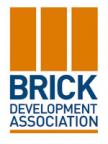A tribute in brick to HRH Elizabeth II
Also Winner of Most Innovative Product at the 2023 Facade Awards

The product and concept
Ketley’s ‘Brixel’ bricks are an innovative and completely new way of creating complex patterns and images in brickwork, which could have a significant impact on the design and construction of architectural facades in the future.
 The Brixel range comprises six unique machine-extruded brick shapes which can be arranged to form two tone textured façade designs and images in a cost effective and commercially viable way.
The Brixel range comprises six unique machine-extruded brick shapes which can be arranged to form two tone textured façade designs and images in a cost effective and commercially viable way.
By using pioneering Brixel digital technology to plan out every detail of an intricate design with absolute precision and accuracy, the brick units can then be manufactured and positioned correctly and with minimal waste. A computer representation of each individual brick shape with a resolution of three pixels enables an optimum level of detailing when creating any relief pattern.
Made from dense Etruria Marl clay, Ketley’s ‘Brixel’ range is made to durable Class A engineering brick standards and is F2 rated for frost resistance, so that they can be used for exposed facades in severe weather locations without risk of degrading.
The first ‘Brixel’ brick facade
To demonstrate the capability and potential of the innovative ‘Brixel’ approach, Ketley designed and constructed for the Platinum Jubilee a unique 3.5 x 3.5 metre silhouette of HM Queen Elizabeth II in brick relief, which is currently on display at The Brickworks Museum in Southampton.
 Approximately 676 Ketley Staffordshire Red brick slips, comprising the six different bespoke brick types, were used in the construction of this intricate façade of subtly changing light and shadows.
Approximately 676 Ketley Staffordshire Red brick slips, comprising the six different bespoke brick types, were used in the construction of this intricate façade of subtly changing light and shadows.
To create such a detailed representation, Ketley Brick divided a classic 2D photo of Queen Elizabeth II into 2,028-pixel 65mm square sections, with each individual brick having a resolution of three pixels. A computer-generated 3D model was then created to determine the precise location of each ‘brixel’ within the design.
The Brixel tool was able to calculate the exact number of each of the six brick types required and the quantities of each to be extruded.
As the relief pattern had to work equally well when viewed from different angles, a special digital lighting tool was used to work out the length and position of the shadows cast by the position of the sun during the day.
The fact that the advanced 3D modelling enabled every detail to be carefully planned and the end result to be visualised meant that the actual brick units could be manufactured and positioned with complete confidence that design concept would work in practice.
Prior to delivery to site the design was put together on the ground with the brick units positioned with reference to the mock up and model. This confirmed how effective this new relief patterning has turned out to be. Conceived as a means for Company Logos or commemorative designs to be made a permanent corrugated feature in a wall, this first project of the most iconic of images, was a triumph and proved how effective this new design technology is at producing lenticular designs with an illusion of depth, with the ability to change or move as they are viewed from different angles. This technique to create three-dimensional parallax panoramagrams, originated in the photographic world to produce stereoscopic imagery, now this can be realised in brickwork as a composition of light and shadows, without the need for a sculptor or artist on site.

Projecting brickwork has increased in popularity in recent years as architects have designed more elaborate and ambitious facades. Now Ketley Brick have opened up new possibilities for intricate, decorative brick designs and the Queen’s memorial sculpture demonstrates just how much detail you can achieve when designing with brick. Commercial Director Richard Dyer explains “We wanted to create a commemorative brickwork sculpture to celebrate the Platinum Jubilee, and we felt a sculpture of the Queen would be a good test of our new design technology as we would need to achieve a high level of detail for it to work effectively and with such a well-known image it would clearly demonstrate what is possible.”
In textured and projecting façades, bricks are exposed on their bed faces with a significantly greater degree of freeze thaw impact than conventional flush brickwork, with the potential for rainwater to sit on the top face, increasing the vulnerability of the brickwork to the effects of freezing and subsequent deterioration. Ketley’s bricks however are of “Class A” engineering quality, with extremely low water absorption, and able to withstand severe omnidirectional freeze-thawing conditions in exposed applications.
The Brixel techniques were developed as a concept following work done on some of the more ambitious textured brick projects in the UK in recent years, including the Victoria Arcade in Leeds and the new HMRC building, Three New Bailey in Salford. Ketley’s new ‘Brixel’ technology can be used to create sculptures in either full bricks or brick slips.
Ketley’s memorial sculpture of the Queen’s Head sculpture is now a lasting tribute to our late Monarch and is on display at The Brickworks Museum in Southampton. The country and world have lost an icon who’s grace, selfless duty and service means she will forever be embedded in our hearts and minds. We mourn her passing and already immortalised in so many ways, this brick sculpture is a tribute and celebration of a life that touched us all.










